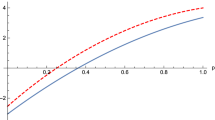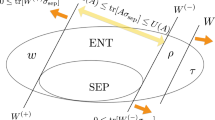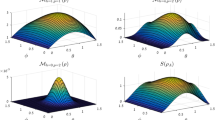Abstract
An effective approach to quantify entanglement of any bipartite systems is D-concurrence, which is important in quantum information science. In this paper, we present a direct method for experimental determination of the D-concurrence of an arbitrary bipartite pure state. To do this, we show that measurement of the D-concurrence of bipartite pure state can be conversed into the measurement performed on some observables so called generalized Gell-Mann operators. We first introduce the concept of D-concurrence for a bipartite system. Then we explain the method of measuring this entanglement measure for the pure state. Finally, for clarify of the subject, we give an example consisting of two parties A and B with dimensions 3.
Similar content being viewed by others
Introduction
One of the weirdest features of the quantum world is entanglement of particles that describes the correlation of fundamental properties that cannot happen by chance. It occurs when pairs or groups of particles interact such that the quantum state of each particle cannot be described independently of the state of the others, even though the individual particles may be spatially separated. Quantum entanglement has applications in the emerging technologies of quantum computing1 and quantum cryptography2, and quantum teleportation3. Quantifying an amount of entanglement of a given state is defined as an entanglement measure. The first step in finding the entanglement measure for a given pure multipartite state was made by Bennett et al.4. They found that the partial entropy of a party in a bipartite quantum state can be a measure of entanglement. Next, the exact formula for the entanglement of formation for all mixed states of two qubits that have not more than two non-zero eigenvalues was obtained by Hill and Wootters5. Also in6, an explicit formula for the entanglement of formation of a pair of qubits as a function of their density matrix is obtained. They5,6 expressed the entanglement of formation of a two-qubit state in terms of the concurrence. The concurrence as an entanglement measures for a given state is zero iff the state is separable and it is equal to one for the maximal entangled states. It is defined for two-qubit pure and mixed states. In7, some direct concurrence measurement protocols are explained for the optical and atomic states such that these protocols encode the concurrence into the success probability for picking up the balanced state. For the higher dimensional bipartite states, Ma et al.8 defined a new entanglement measure that is called D-concurrence that has deep connection with the concurrence. In9, some of new upper and lower bounds of D-concurrence of the compound states are obtained. On the other hand, because of some unphysical quantum operation in the definition of the entanglement measures, such as complex conjugation in the concurrence6, in order to directly measure the entanglement of any quantum state, there isn’t measurable observable. If we can write the density matrix of a quantum state in terms of observables that are measurable, then we can experimentally determine the entanglement. This method is called tomography of the quantum state10. But this is not always practical, especially in the systems with the higher dimensions, since in these cases, the observables needed to measure the entanglement increase rapidly. Observables such as Pauli operators can be used for measuring the concurrence of two qubit pure states as an entanglement measure11. Zhou et al.12 found an efficient way for measuring the concurrence of the entanglement atoms using single photons. Sheng et al.13 showed that measuring the concurrences for polarization and momentum entanglements can be measured directly and proposed an way for measuring the concurrence for the hyperentanglement. The approaches of the concurrence measurement in both a linear and a nonlinear optical system and some ways for measuring the concurrence of the atomic entanglement system were introduced by Zhou and Sheng in7. The direct method for determining the negativity of an two-qubit state as an entanglement measure using relation between the purity, negativity and a universal entanglement witness was described by Bartkiewicz et al.14. In15, Tukiainen et al. proposed a protocol to quantify the concurrence of any two-qubit pure state using weak measurements and weak values. Also, a direct method for measuring quantum entanglement of arbitrary two-qubit states through Hong-Ou-Mandel interference has been described by Bartkiewicz et al. in16. In17, Walborn et al. proposed a protocol in which the concurrence of any pure quantum state can be experimentally determined by a simple projective measurement provided one has access to twofold copy of the state. Also, in18, Zhang et al. presented three schemes for directly measuring the concurrence of two-photon polarization-entangled pure and mixed states. In the case of measurability of the entanglement measures for the quantum systems with more than two-qubit, in19 we obtained the measurability of the polynomial invariant of degree 2 for even- N qubit pure states20. Given these papers and the importance of the measurability of the entanglement measures, has led us to investigate the measurability of one of the entanglement measures, so called, D-Concurrence in paper. In this paper, we give a physical interpretation of D-concurrence of an arbitrary d dimensional pure state and show that the measuring of the D-concurrence of any bipartite pure state can be conserved into measuring of generalized Gell-Mann operators.
The organization of this paper is as follows: In the first section of this paper, we review the concept of D-concurrence for a bipartite system. In section 3, we explain a direct method of measuring this en- tanglement measure for bipartite pure state. In section 4, for clarify of the subject, we give an example consisting of two parties A and B with dimension 3. Finally, we conclude the paper in the last section.
D-concurrence
Consider the system consists of two parties A and B with corresponding state spaces of HA and HB. The state of the system is \(|\psi \rangle \in {H}_{A}\otimes {H}_{B}\). If the dimension of \({H}_{A}\otimes {H}_{B}\) is finite, then the D-concurrence of the system is given by:
which ρA represents the reduce density matrix, i.e., \({\rho }_{A}=T{r}_{B}(|\psi \rangle \langle \psi |)\). This definition is extended to the mixed states by means of the convex roof extension. Mathematically, for the mixed state \(\rho =\sum _{i}{p}_{i}|\psi \rangle \langle \psi |\) with \(\sum _{i}{p}_{i}=1\), the D-concurrence is defined as
which \(\{{p}_{i},|{\psi }_{i}\rangle \}\) is the ensemble of a pure state for the given density matrix. The ensemble that minimizes C(ρ) is called optimal21.
On the other hand for the infinite dimensional of the Hilbert space \({H}_{A}\otimes {H}_{B}\), it can be shown that if the Schmidt decomposition of \(|\psi \rangle \) is as \(|\psi \rangle =\sum _{k}{\lambda }_{k}|k\rangle |k^{\prime} \rangle \), then22
The proof of the above equation is as follows: For this state \(|\psi \rangle \), the reduce density matrix ρA is the diagonal matrix with the elements as \({\rho }_{A}=Diag\{{\lambda }_{1}^{2},\,{\lambda }_{2}^{2},\mathrm{..}.,{\lambda }_{k}^{2}\}\). Given that \({\lambda }_{1}^{2}+{\lambda }_{2}^{2}+\mathrm{..}.+{\lambda }_{k}^{2}=1\) and using Eq. (2.1), we have:
In the following section, we describe a direct method to determine the D-concurrence of an arbitrary bipartite pure state in experiments.
Measurability of D-concurrence
In this paper, we want to investigate the physical interpretation of the D-concurrence defined by Eq. (2.4) that makes to measure of it directly. To do this, we use the definition of the total variance given in10
which \({\Lambda }_{\alpha }\) are the local observables so that
that \({\Lambda }_{i}^{A}\) and \({\Lambda }_{j}^{B}\) are orthonormal bases in the space of Hermitian operators HA and HB respectively. They are the standard SU(N) generators (in our study N = d) that are the generalized Gell-Mann matrices (GGM). In fact they are the extensions of Pauli matrices in higher dimensions for qubits and the Gell-Mann matrices for qutrits and defined as three different kinds of matrices as follows23:
- (i)
\(\frac{d(d-1)}{2}\) symmetric GGM
$${\Lambda }_{s}^{jk}=|j\rangle \langle k|+|k\rangle \langle j|,\,1\le j < k\le d,$$(3.7) - (ii)
\(\frac{d(d-1)}{2}\) antisymmetric GGM
$${\Lambda }_{a}^{jk}=-\,i|j\rangle \langle k|+i|k\rangle \langle j|,\,1\le j < k\le d,$$(38) - (iii)
(d−1) diagonal GGM
which all GGM are Hermitian and orthogonal and form a basis. Also in Eq. (3.6), I is the identity operator.
Since \([{\sum }_{i=1}^{{d}^{2}-1}{\Lambda }_{i}^{2},{\Lambda }_{i}]=0\), so \({\sum }_{i=1}^{{d}^{2}-1}{\Lambda }_{i}^{2}\) forms a Casimir operator, i.e. \({\sum }_{i=1}^{{d}^{2}-1}{\Lambda }_{i}^{2}\) is proportional to identity. Therefor:
which it may be rewritten as
By tracing of the both sides of above relation, we get:
and then
so:
On the other hand:
The first term on the right side of the above equation can be written as:
which ρA is the reduced density matrix of the subsystem A. It can be rewritten in terms of the diagonal reduced density matrix of \({\rho }_{D}^{A}\) by using the local unitary transformations U. That is:
so
and as a result, we have:
which
Similarly, one can obtain the second term on the right side of Eq. (3.11) as follows
which \({\rho }_{D}^{B}\) is the diagonal reduced matrix of subsystem \(B\) and
In summary, using the Eqs. (3.5, 3.10, 3.12, 3.13) we obtain:
On the other hand, it can easily be shown that:
So, finally we obtain:
Then
Thus, the amount of entanglement carried by a pure two-partite state can be determined by measurement of mean values of the basic observables.
Example
The physically implement of the qubits, qudits and the projective measurements are the cornerstones of the quantum states measurements. To clarify the qualitative analysis of the resource requirement for the procedure and the concepts of the pervious section, in this section we investigate Eq. (3.17) for the system consisting two parties A and B whose dimensions are 3, namely, d = 3. For d = 3, eight Gell-Mann matrices are as the following form23:
so
since \({\sum }_{i}{\lambda }_{i}^{2}=1\), and by using Eq. (2.3), we have
similarly:
then, using Eqs. (3.10) and (3.5) we obtain:
and therefore
which is in fully agreement with Eq. (3.17) by putting d = 3.
The general qudit density matrix can be written as the following form:
which symbol I represents the unit matrix in d dimensions and S0 = 1. This density matrix is parametrized by d2 − 1 real parameters, called generalized Stokes parameters, (\({S}_{jk}^{{\Lambda }_{s}},{S}_{jk}^{{\Lambda }_{a}}\) and \({S}_{l}^{\Lambda }\)) that are measurable. In fact, by introducing optical qudits and describing optical components which are required for the realization of projective measurements, one can have a transition to quantum optics field24. This work is done in25 and a qualitative analysis of Gell-Mann parameters is given for a quantum three-mode Bose system. They obtained the variances of the Gell-Mann parameters for the optical field in the coherent state that determine fluctuations in the system. These variances are measurable. Similarly, we can measure the Gell-Mann operators. So by means of SU(3) symmetry, the schematic diagram of the SU(3) interferometer for measuring the Gell-Mann parameters, will be similar to the Fig. 1 in26.
Conclusion
In summary, we have described the direct measurement of D-concurrence as an entanglement measure of any bipartite system. It is shown that the direct measurement of D-concurrence of any bipartite pure state can be encoded into the measuring of the some obsevables so-called generalized Gell-Mann operators. Finally, we have obtained the measurability of concurrence of bipartite pure state with dimension 3 by means of Gell-Mann matrices as an observables.
References
Ekert, A. & Jozsa, R. Quantum computation and Shor’s factoring algorithm. Rev. Mod. Phys. 68, 733 (1996).
Ekert, A. Quantum cryptography based on Bell’s theorem. Phys. Rev. Lett. 67, 661 (1991).
Bannett, C. H., Brassard, C., Jozsa, R., Peres, A. & Wooters, W. K. Teleporting an unknown quantum state via dual classical and Einstein-Podolsky-Rosen channels. Phys. Rev. Lett. 70, 1895 (1993).
Bennett, C. H., DiVincenzo, D. P., Smolin, J. A. & Wootters, W. K. Mixed-state entanglement and quantum error correction. Phys. Rev. A 54, 3824 (1996).
Hill, S. & Wootters, W. K. Entanglement of a Pair of Quantum Bits. Phys. Rev. Lett. 78, 5022 (1997).
Wootters, W. K. Entanglement of Formation of an Arbitrary State of Two Qubits. Phys. Rev. Lett. 80, 2245 (1998).
Zhou, L. & Sheng, Y.-B. Concurrence Measurement for the Two-Qubit Optical and Atomic States. Entropy 17, 4293 (2015).
Ma, Z. H., Yuan, W. G., Bao, M. L. & Zhang, X. D. A new entanglement measure: D-concurrence. Quan. Inf. Comput. 11, 0070 (2011).
Na-Na, W. & Yuan, L. Some Properties of D-Concurrence. Commun. Theor. Phys. 58, 483–486 (2012).
Klyachko, A., Öztop, B. & Shumovsky, A. S. Measurable entanglement. Appl. Phys. Lett. 88, 124102 (2006).
Aolita, L. & Mintert, F. Measuring Multipartite Concurrence with a Single Factorizable Observable. Phys. Rev. Lett 97, 050501 (2006).
Zhou, L. & Sheng, Y. B. Detection of nonlocal atomic entanglement assisted by single photons. Phys. Rev. A 90, 024301 (2014).
Sheng, Y. B., Guo, R., Pan, J., Zhou, L. & Wang, X. F. Two-step measurement of the concurrence for hyperentangled state. Quantum Inf. Process. 14, 963–978 (2015).
Bartkiewicz, K., Beran, J., Lemir, K., Norek, M. & Miranowicz, A. Quantifying entanglement of a two-qubit system via measurable and invariant moments of its partially transposed density matrix. Phys. Rev. A 91, 022323 (2015).
Tukiainen, M., Kobayashi, H. & Shikano, Y. Quantification of concurrence via weak measurement. Phys. Rev. A 95, 052301 (2017).
Bartkiewicz, K., Chimczak, G. & Lemr, K. Direct method for measuring and witnessing quantum entanglement of arbitrary two-qubit states through Hong-Ou-Mandel interference. Phys. Rev. A 95, 022331 (2017).
Walborn, S. P., Ribeiro, P. H. S., Davidovich, L., Mintert, F. & Buchleitner, A. Experimental determination of entanglement by a projective measurement. Phys. Rev. A 75, 032338 (2007).
Zhang, L. H., Yang, Q., Yang, M., Song, W. & Cao, Z. L. Direct measurement of the concurrence of two-photon polarization-entangled states. Phys. Rev. A 88, 062342 (2013).
Heshmati, A., Yahyavi, M., Karimi, N., Jafarizadeh, M. A. & Mahmoudi, P. Measurability of the polynomial invariant of degree 2 for even-N qubit states. Quantum Inf Process. 18, 243 (2019).
Jafarizadeh, M. A., Yahyavi, M., Karimi, N. & Heshmati, A. Entanglement in four qubit states: Polynomial invariant of degree 2, genuine multipartite concurrence and one-tangle. Phys. Lett. A 383, 707 (2019).
Rungta, P. & Caves, C. M. Concurrence-based entanglement measures for isotropic states. Phys. Rev. A 67, 012307 (2003).
Guo, Y., Hou, J. & Wang, Y. Concurrence for infinite-dimensional quantum systems. Quantum Inf Process 12, 2641–2653 (2013).
Bertlmann, R. A. & Krammer, P. Journal of Physics A: Mathematical and Theoretical Bloch vectors for qudits. J. Phys. A: Math.Theor. 41, 235303 (2008).
Bayraktar, Ö., Swillo, M., Canalias, C. & Björk, G. Quantum-Polarization State Tomography. Phys. Rev. A 94, 020105(R) (2016).
Alodzhants, A. P. & Arakelian, S. M. Quantum Measurements of the Parameters of the Gell-Mann Optical Field with an SU(3) Interferometer. Opt. Spectrosc. 97, 453 (2004).
Alodjants, A. P., Leksin, A. Y. & Arakelian, S. M. Quantum operational measurement of amplitude and phase parameters for SU(3) symmetry optical fields. J. Opt. B: Quantum Semiclass. Opt. 7, S745 (2005).
Acknowledgements
This research has been supported by University of Tabriz, Farhangian University of Tehran, and Shabestar Branch Islamic Azad University.
Author information
Authors and Affiliations
Contributions
N. Karimi analyzed and interpreted the results; contributed to the organization of the manuscript. A. Heshmati performed the initio calculations, analyzed and interpreted the results. M. Yahyavi performed the initio calculations, analyzed and interpreted the results, wrote the main manuscript text. M.A. Jafarizadeh conceived the work, analyzed and interpreted the results, reviewed the main manuscript. A. Mohammadzadeh contributed to the calculation. All authors commented on and reviewed the manuscript.
Corresponding author
Ethics declarations
Competing interests
The authors declare no competing interests.
Additional information
Publisher’s note Springer Nature remains neutral with regard to jurisdictional claims in published maps and institutional affiliations.
Rights and permissions
Open Access This article is licensed under a Creative Commons Attribution 4.0 International License, which permits use, sharing, adaptation, distribution and reproduction in any medium or format, as long as you give appropriate credit to the original author(s) and the source, provide a link to the Creative Commons license, and indicate if changes were made. The images or other third party material in this article are included in the article’s Creative Commons license, unless indicated otherwise in a credit line to the material. If material is not included in the article’s Creative Commons license and your intended use is not permitted by statutory regulation or exceeds the permitted use, you will need to obtain permission directly from the copyright holder. To view a copy of this license, visit http://creativecommons.org/licenses/by/4.0/.
About this article
Cite this article
Karimi, N., Heshmati, A., Yahyavi, M. et al. Measurability of D-concurrence. Sci Rep 9, 19415 (2019). https://doi.org/10.1038/s41598-019-54247-2
Received:
Accepted:
Published:
DOI: https://doi.org/10.1038/s41598-019-54247-2
This article is cited by
-
The Relations of Reduced Density Matrices and the N-Tangle for Even-N Qubit States
International Journal of Theoretical Physics (2023)
Comments
By submitting a comment you agree to abide by our Terms and Community Guidelines. If you find something abusive or that does not comply with our terms or guidelines please flag it as inappropriate.



